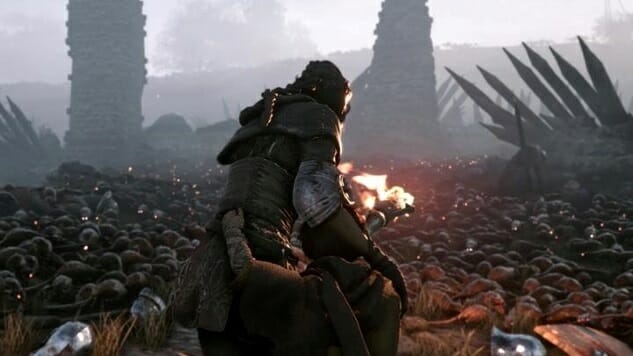Death Gets Heavy in A Plague Tale: Innocence

Few games are as drenched in death as A Plague Tale: Innocence. Set in 14th century France, when both the Hundred Years’ War and the Black Death are decimating Europe, Asobo Studio’s adventure follows a young brother and sister struggling to avoid the English, the Inquisition, and the seas of man-eating rats that periodically burst out of the ground like red-eyed geysers. Along the way Amicia and Hugo De Rune (she’s 13 or so, he’s probably five) will witness people being burned at the stake, run through village streets covered in infected corpses, and even wade through legions of dead soldiers cluttering a battlefield in order to escape capture. It’s a bleak world these two inhabit, and all of its occasional moments of childlike levity inevitably give way to new and extended medieval horrors.
Despite death surrounding her on all fronts, Amicia doesn’t want to kill. She’s still a child when the game starts, and even though she quickly realizes the danger she and her brother are in, she’s also still clinging to the morality her parents instilled within her. Together she and Hugo run and hide, creeping through tall grasses and crouching behind wagons and fences, trying as hard as possible to not be seen by anybody.
That doesn’t always work, though. And when it doesn’t—when Amicia eventually finds herself in a situation where there’s only way to survive—A Plague Tale portrays it as the momentous and life-changing decision that it is. As Amicia slings a rock towards the head of her assailant, everything slows down. The edges blur out. The act sears itself in her memory, when Amicia becomes not just death’s prey but an active co-conspirator. A brief cut-scene registers the shock and grief on her face, the realization that she just committed a mortal sin, and that any hope of returning to the childhood she’s been forced out of is now gone. It’s perhaps the most powerful moment in a surprisingly nuanced game full of powerful moments.
It’s also not the extent of Amicia’s internal struggle with killing. For most of A Plague Tale Amicia doesn’t have to kill. She can sneak past enemies or distract them by throwing jars or rocks. She rarely even kills rats, using light and flame to drive them away. She will wind up killing again, but it’s not like the recent Tomb Raider reboot, where Lara Croft goes from reluctantly killing one person to slaughtering indiscriminately like a Rambo-esque human killing machine. The second time Amicia absolutely has to kill, she again hesitates, although not as dramatically as before. It hurts that the unthinkable has become a necessity, and even though she only kills in self-defense, she’s still visibly distraught about that.